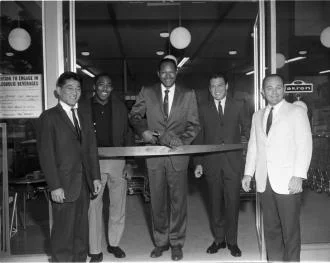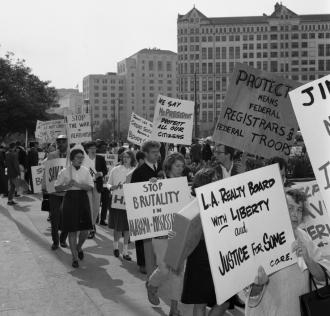African Americans in Los Angeles, 1945–2000
Four Instructional Units
Each unit includes multiple lessons, aligned with the History-Social Science Content Standards for California Public Schools in the 11th grade: United States History and Geography: Continuity and Change in the Twentieth Century
- African Americans at Work in Post - WWII Los Angeles
- Race, Housing and the Fight for Civil Rights in Los Angeles
- The Struggle to Desegregate Los Angeles Schools, 1940-1970
- The Intentional Civility of Mayor Tom Bradley
Photographs and Oral Histories
The Tom & Ethel Bradley Center at California State University, Northridge, administers the following resources:
- Over 17 thousand photographs of African Americans active in politics, law, civil rights, music and entertainment, sports, religion, and social organizations of the city of Los Angeles from the 1950s to the 1990s, taken by three prominent photographers — Charles Williams, Harry Adams, and Guy Crowder. From 2014-2017, the collections are being digitized with the assistance of a federal grant. Check out all our digital collections.
- An interactive California School of Photography, Los Angeles timeline that offers a representative sample of the photographs.
- A collection of over 45 oral histories — interviews of members of the African-American community, most on audio, some on video, including short summaries of each interview. Sample interview with Gwen Green.

Major Components and Principles of the 11th Grade Curriculum
The curriculum consists of:
- A set of overarching questions guiding the curriculum – "The Big Questions"
- A general guide for viewing and analyzing photographs
- 10 individual 1-hour lessons each addressing one content substandard of the 11th grade curriculum (4 already finished)
The principal method or approach is that for a particular content standard, lesson, or unit of instruction, students are provided several photographs, and students read, do research and write in order to create PPT-type slideshows, posters, essays, and presentations.
Students evaluate and interpret photographs as historical sources and texts, and create their own historical narratives.
California School of Photography, Los Angeles Interactive Timeline
Potential Contribution of Curriculum
The potential contribution of these visual collections is to enable Los Angeles-area teachers and students to explore the Civil Rights movement as it happened in this region. There is an abundance of curricula covering the Civil Rights era nationwide, principally in the Deep South and Washington, D.C., but virtually none supports a study of that era in Los Angeles. The proposed lesson plans may enable LAUSD teachers to better engage and sustain student interest in that historical time period.
Dear colleague,
It is with a great deal of both concern and hope for the future of the U.S.A. that we announce the launch of the Bradley Digital History Project, a set of on-line lessons and other resources featuring photographs of Los Angeles' African-American community from the 1940s to the 1990s.
2017 has been a difficult year for the country. Racial misunderstandings are in a high state of tensions, and old wounds from the Civil War have been re-opened. The relationship between the police and the African-American community is frayed, again, as it has seemed to be since the fire hoses and batons of the 1960s.
This new curriculum provides teachers a fresh look at the African-American experience, a regional one anchored in Los Angeles, sprinkled with a bit of Hollywood glitter, but unafraid to explore some of the darkest undersides of a largely unknown history.
From the 1940s to the 1990s, more than 17,000 images from three photographers - Charles Williams, Harry Adams, and Guy Crowder – provide evidence that there was a large, vibrant African-American community that had an important presence in Los Angeles, active in politics, law, civil rights, music and entertainment, sports, religion, and social organizations. What happened to that community from the 1990s to the present time? Where did it go? And while the community does not have the presence it had from the 1950s to the 1990s, how might that change? How can a community recover some of its past?
Four sets of lessons ask challenging questions, and provide teachers and their students access to the photographs which have been digitized with the assistance of a federal grant from the National Endowment for the Humanities, video and audio oral interviews, maps and interesting ideas for classroom activities.
- African-Americans at Work in Post-WWII Los Angeles: To what extent were African Americans marginal workers needed in times of economic prosperity. To what extent were they an integral part of the Los Angeles economy, laying the basis for social and political integration?
- Race, Housing and Civil Rights in Los Angeles: Why have "white" people historically been so resistant and opposed to living close or next to African-Americans? Once African-Americans achieved legal victories such as the abolishment of racially restrictive housing covenants, did they get what they wanted, but lose what they had?
- Race, Education and Desegregation in Los Angeles: How valid or fair is it to ask why "white" people have historically been so resistant and opposed to having their children go to school with African-American children? What factors other than race have made desegregated schools so difficult to achieve in Los Angeles?
- The Intentional Civility of Mayor Tom Bradley: In the Los Angeles of the 1960s and 1970s, more than 50 years ago, it can be argued that poverty, crime, racism, and racial and ethnic strife were even worse than they are today. In that context, how was a single African-American public official able to get so many people of all different backgrounds to work together? On the other hand, given that he was a former police officer, why did he experience such a difficult relationship with the Los Angeles Police Department?
We encourage you to review these lessons, attempt them in your classroom, share them with like-minded educators, and commit to revisiting and reinterpreting and rewriting history the way every new generation should.
Make America think again.

